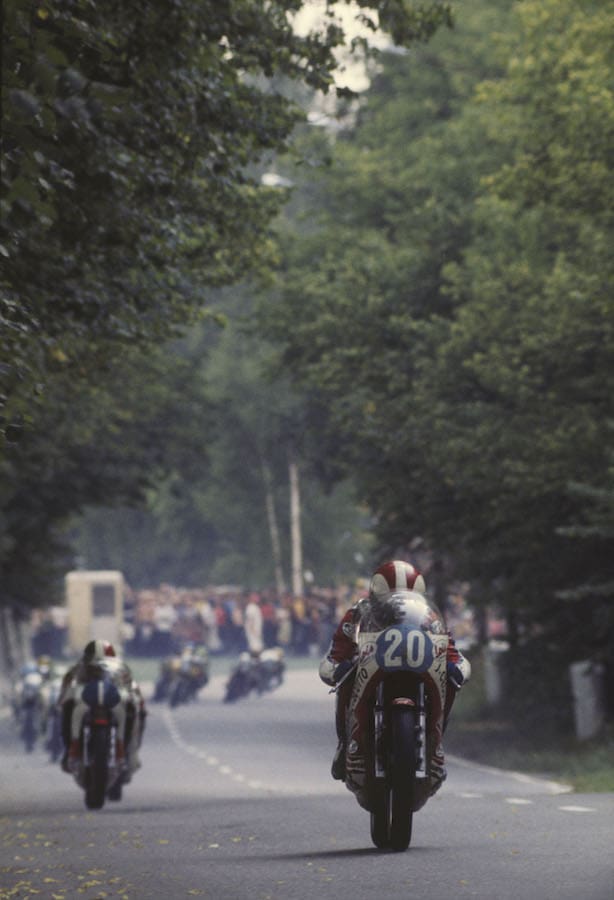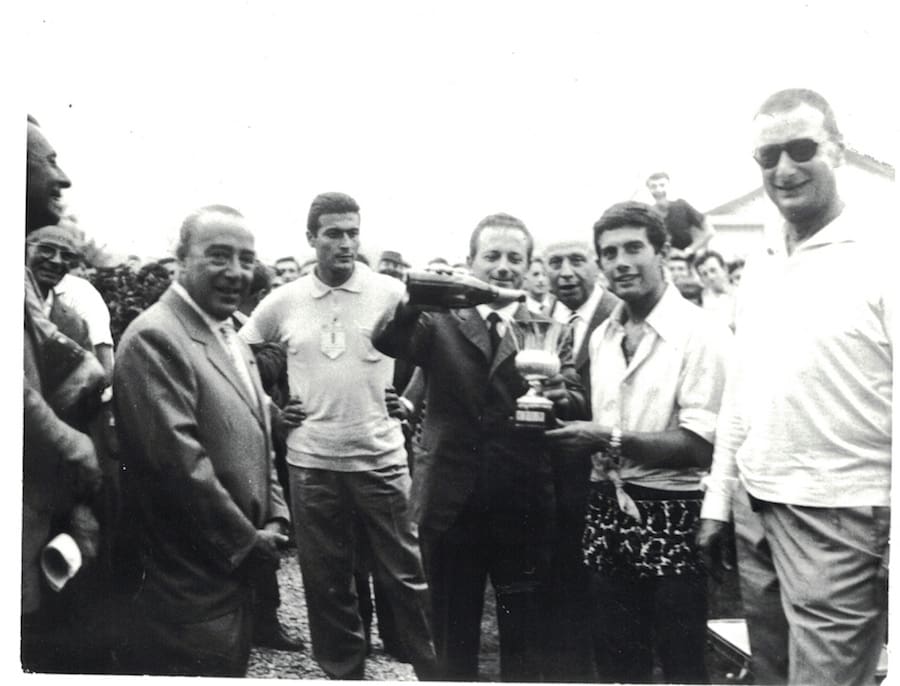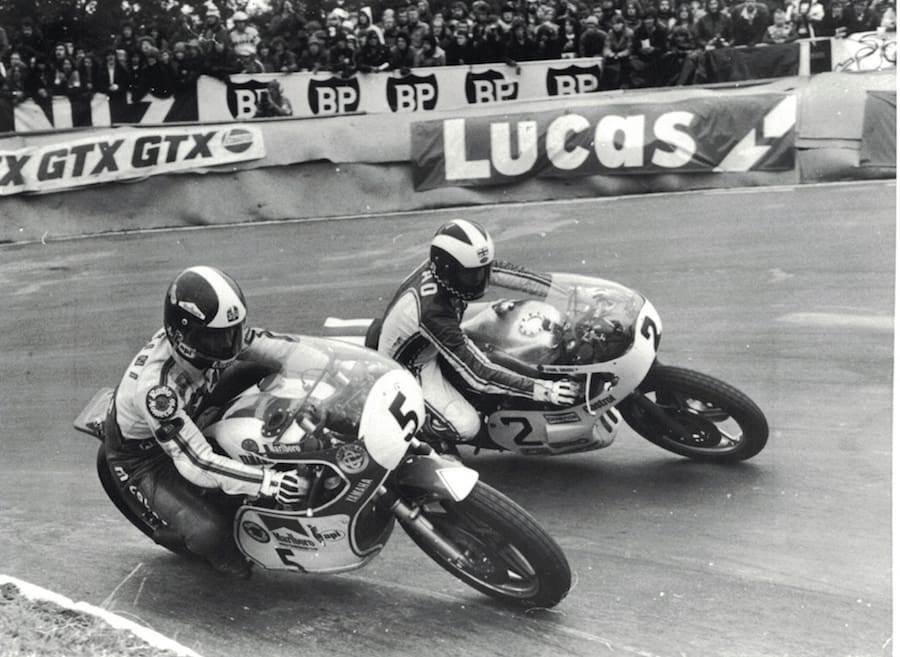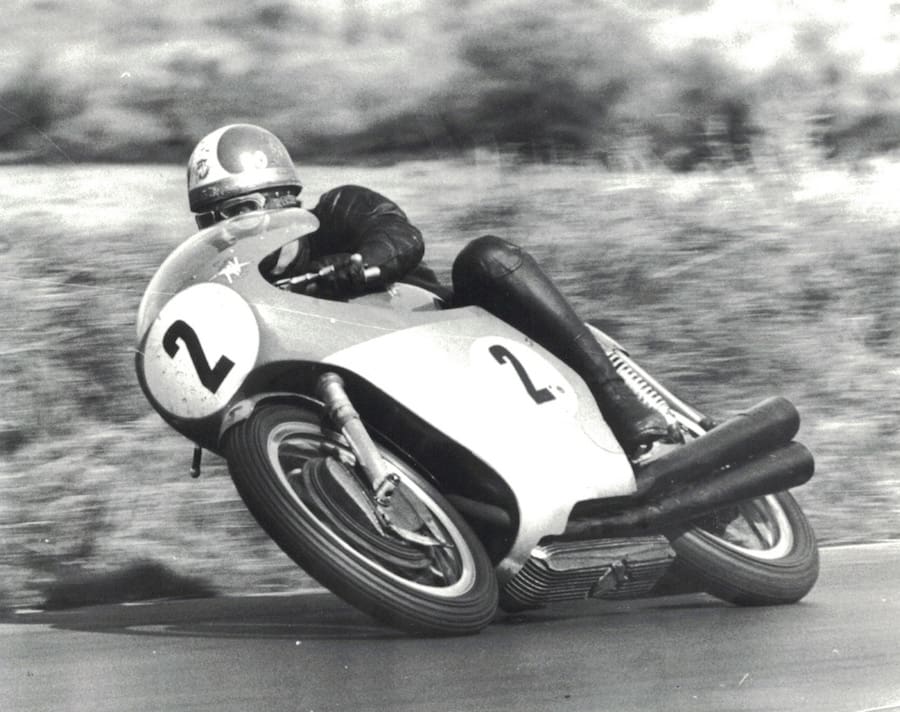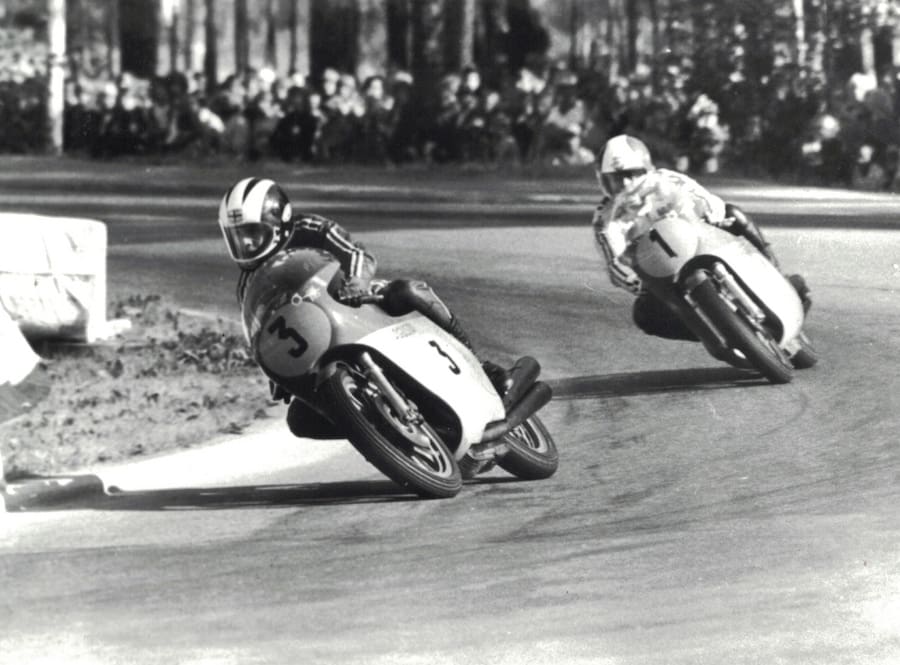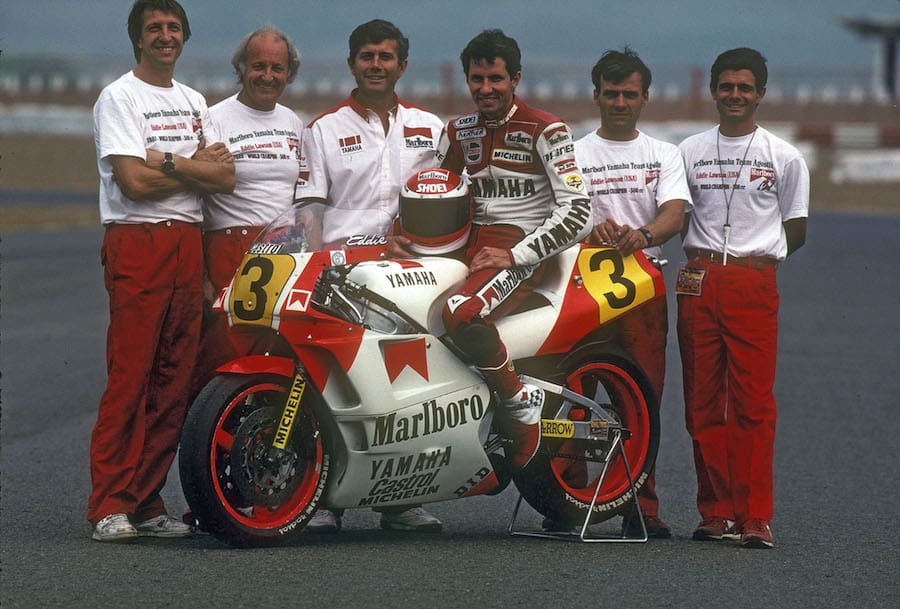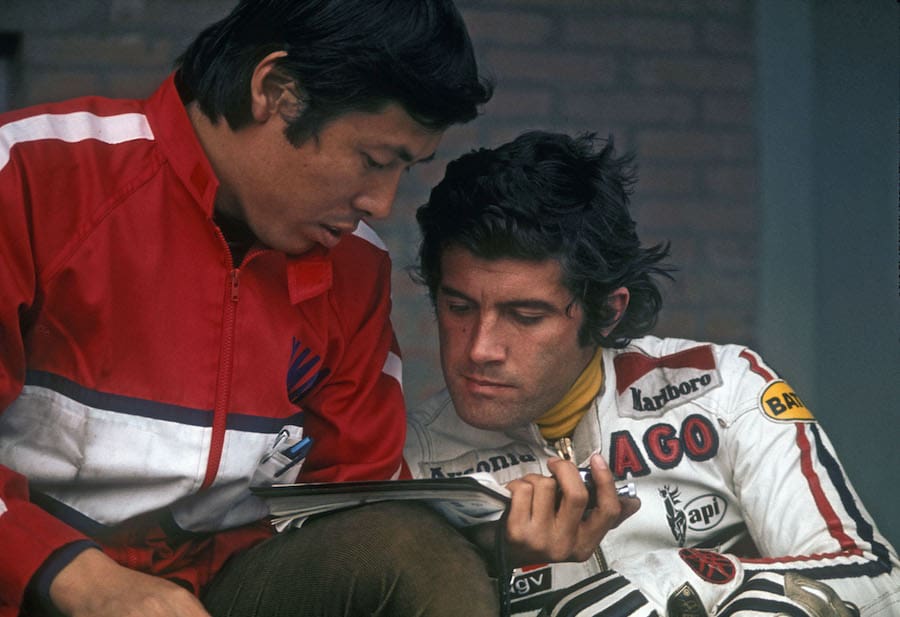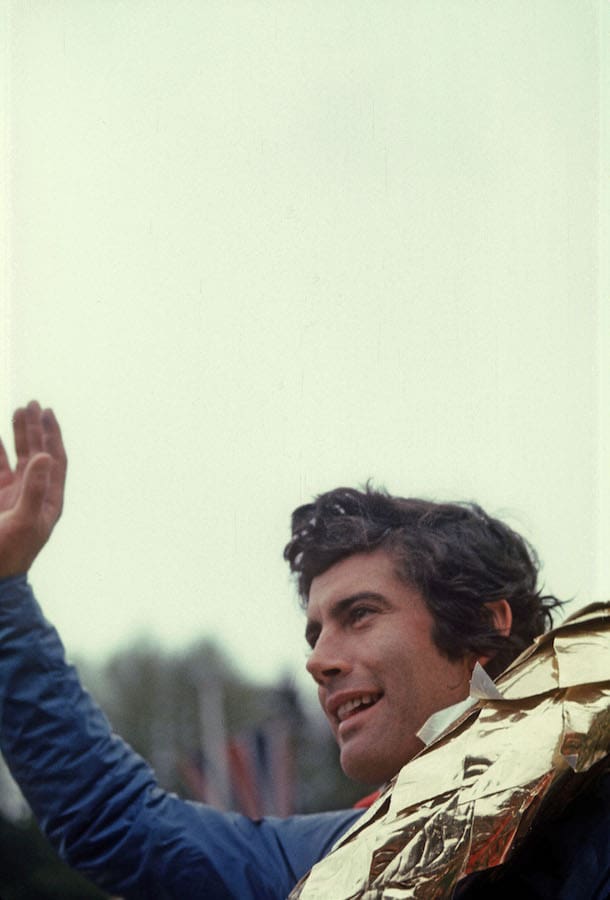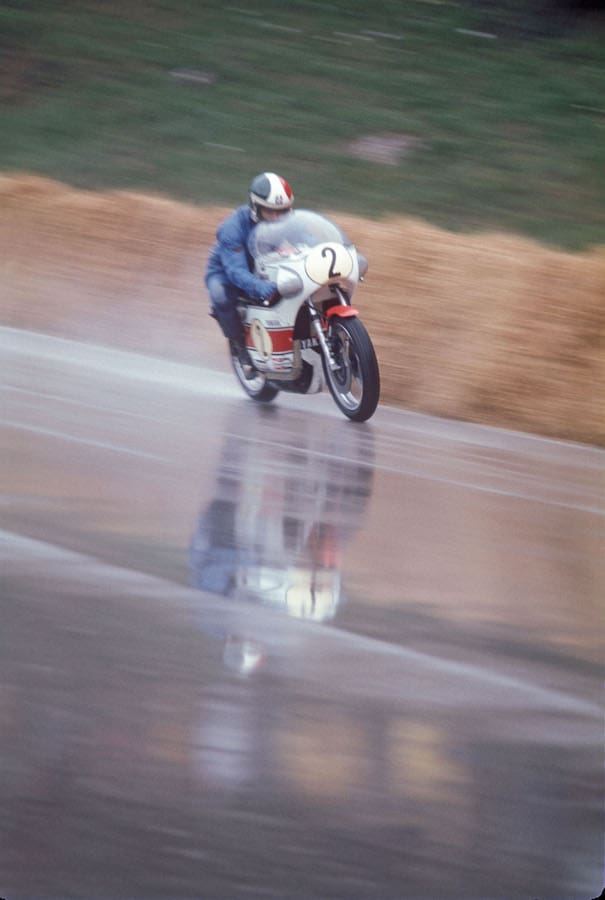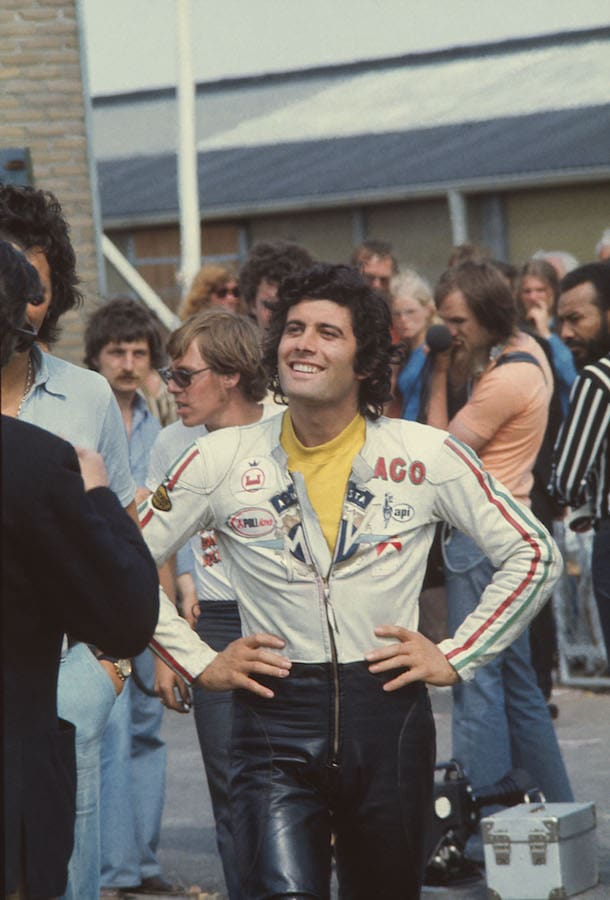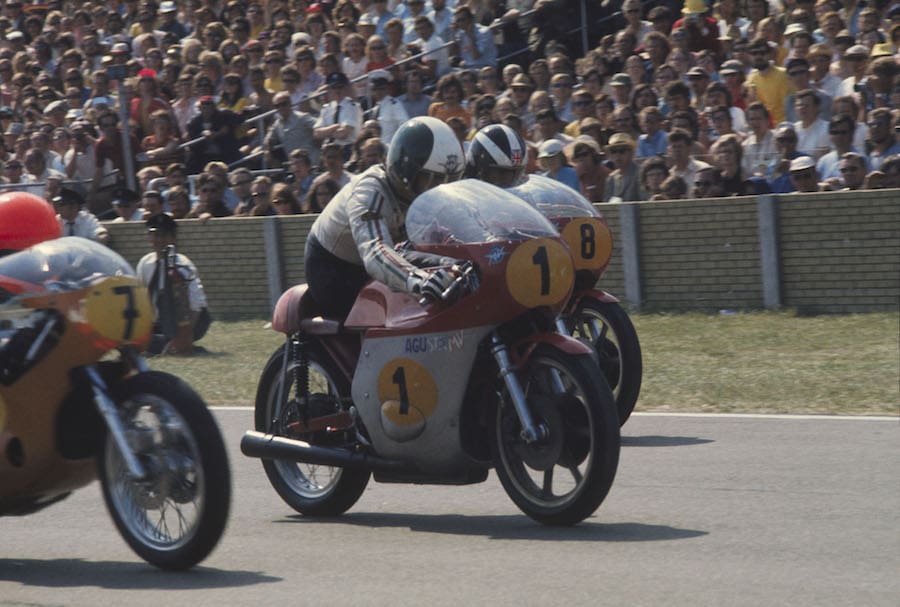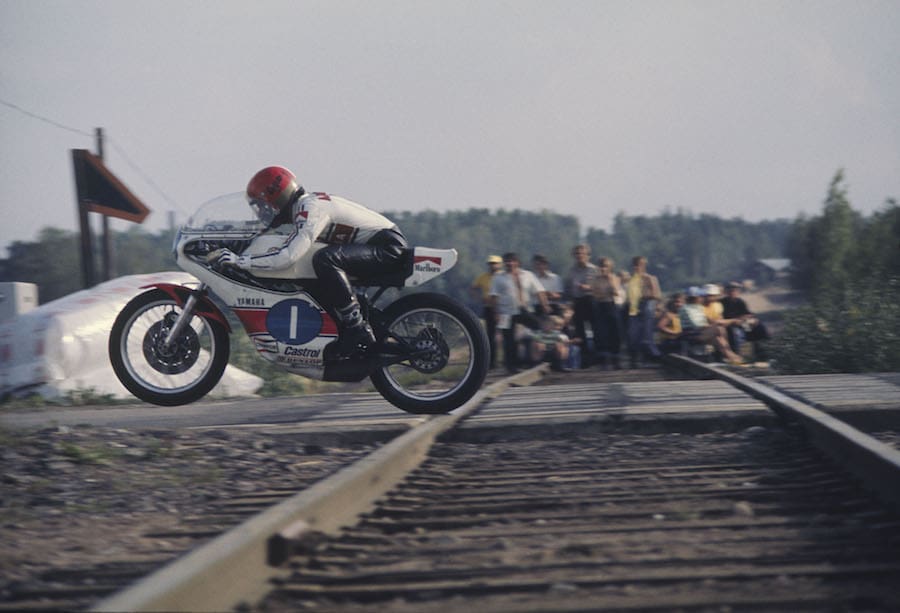At the end of 1964, a 22-year-old Italian racer was summoned to the Meccanica Verghera factory in Lombardy. When the boss of MV called, you answered.
Giacomo Agostini had won the ’64 Italian 250 Championship on a works Morini single. He had only ridden three 250 Grands Prix, finishing fourth at both Solitude in West Germany and Monza, behind three top Japanese factory riders at both venues.
While impressed, Count Domenico Agusta soon let Agostini know who was in charge.
“He kept me waiting for six hours, until 11pm,” Agostini said. “Then I went into his office and he said: ‘What you want?’
“I want to race with your bike,” said the interviewee.
It’s a classic old-school Italian team-owner story. It also represents a pivotal moment in the sport’s history, the meeting where MV hired a home-grown future superstar.
The Count wanted Agostini to ride alongside Mike Hailwood, who had just claimed his third consecutive world 500 championship and MV’s eighth premier-class title in a row, on the venerable eight-valve MV 500-four. Count Agusta wanted an Italian champion. All MV’s 350 and 500 titles to date had been won by riders born in England or Wales.
Agostini was the eldest son of a Bergamo transport company owner who operated ferries on Lake d’Iseo and built roads. His heroes included Bergamo’s Carlo Ubbiali, Tarquinio Provini, Gary Hocking and John Surtees – all world champions for MV.
Unlike Hailwood’s millionaire father Stan, Agostini Snr opposed his son’s racing. But when Giacomo was 18, a lawyer signed his licence application, thinking it was for bicycle racing.
Success on a private Morini 175 earned Agostini a factory ride and he recalls the Morini 250 having fantastic handling. He was less taken when he tried the MV 500-four, describing it as big, heavy and difficult. However, MV was building a new machine, a 12-valve 350 triple with a seven-speed gearbox.

Agostini did the development riding over the winter and hence began the 1965 GP season with a machine that suited him. He won the opening round at a rain-lashed Nürburgring Südschleife (South Circuit) – the first time Honda’s Jim Redman had lost a 350 GP since 1963. In fact the Honda hard man fell off trying to stay with the rookie.
Later in the day, Hailwood reminded everyone who was numero uno, beating his new teammate by a minute and three quarters in the 500 race.
In his first Isle of Man TT, Agostini took a podium finish in the 350 race and crashed in the 500, fortunately without injury.
Redman won four 350 rounds on the trot after Germany and then Agostini won two in succession. He was leading the Japanese GP at Suzuka, the season finale, when the MV triple broke a points spring. The Italian limped home fifth on two cylinders – any hope of a debut-season title dashed.
Meantime, in the 500 class, Agostini recorded his first premier-class victory in Finland, giving him a double for the day, and chiselling away at the gap between himself and Mike the Bike. It was 11 seconds in the last 500 GP of the season at Monza.
Crucially, Agostini was building knowledge all the time, both about the circuits and about riding a 500. “I learned from Mike and we had a good time together – he was a gentleman. He tried 100 per cent to win, but with respect.”
Agostini put more effort into testing, confirmed when they swapped bikes at a practice day.
“Mike was a very good rider, very fast, but he didn’t know about the bikes – he would just go fast,” Ago said. “I used to work hard with the bikes, keep notes and things. He just wanted to open the throttle.”
There was a major change for 1966 when Hailwood signed with Honda, where he could contest three classes – 250, 350 and 500. It would be Honda’s first crack at the premier class.
Hailwood was tired of the constraints at MV. The Count, now convinced that Agostini had the goods, didn’t try to out-bid the world’s largest manufacturer for Hailwood’s signature. The scene was now set for a proper showdown in the 500 class, after years of MV owning the category.
Honda’s new 500 was a 16-valve 500-four. The plan was for Hailwood to chase the 250 and 350 titles, and support team captain Redman with the new 500. Redman was the anointed Honda rider for the premier class, as reward for his brand loyalty and multiple 250 and 350 championships. In his autobiography, he mentions telling this to Hailwood.
Here is an example of the difference between GP motorcycle racing of the 1950s and 1960s, and modern times. Redman was more than the number one rider. He was quasi team manager and had called many of the shots in the Honda team since 1962. Hailwood didn’t receive the first choice of machines until three rounds into the title.
Redman won the first two 500 GPs of 1966, then sustained a broken left wrist when he crashed in the rain at Spa-Francorchamps while chasing Agostini’s old Quattro cilindri MV. Hailwood had meantime retired his Honda from the race lead with gearbox problems, his third non-score in three 500 races. Faced with six weeks on the sidelines and missing at least three GPs, Redman retired.
Agostini had, meantime, begun the 500 championship with the four cylinder, finishing half a minute behind Redman at Hockenheim. For the second round at Assen, MV stretched the 350 triple out to 377cc.
Agostini finished second, 2.2 seconds behind Redman, in a race where Hailwood retired after setting fastest lap. As a clear indication of the potential of the triple, Agostini’s race time was half a minute faster than Hailwood’s winning time a year earlier on the MV four.
Agostini won in Belgium, and then crashed out of the race lead in the East German GP at over 200km/h after setting fastest lap. A week later at the Czech GP, the MV mechanics put the three-cylinder engine (now more than 400cc) in the old 500-four chassis. This hybrid bike and its still-sore rider finished a minute and quarter behind Hailwood, who claimed his first 500 win on a Honda.

But at Imatra in Finland, Agostini beat Hailwood by 41 seconds. The next two rounds were the Ulster GP and a postponed Isle of Man TT (due to a dock strike in June). Hailwood beat Agostini twice.
It was now down to the final round at Monza. The MV had been bored out to more than 470cc and the Honda was again let down by its gearbox. Agostini won the race and took the championship by six points. The apprentice had beaten the master and become the first Italian to win the world 500 title since Libero Liberati (Gilera) in 1957.
Sixty-seven was even tighter, as Agostini and Hailwood turned on the 500 battle of the decade. With eight races run, each had scored four victories. Agostini had won at Hockenheim, Spa-Francorchamps, Sachsenring and Imatra.
Hailwood’s victories included a classic Isle of Man battle, where both lapped at 108 mph before the MV broke its drive chain. Agostini said it was the biggest disappointment of his career. He was eight seconds in front of the rider he most admired, on Mike’s turf.
The pair had another big duel at Assen, where Hailwood won by five seconds. Once more, the Italian GP at Monza was crucial. Hailwood looked set to win, until his gearbox jammed in top gear and Agostini passed him with one lap remaining. Hailwood won the final round in wet and miserable conditions at Mosport, Canada, but Agostini’s second place sealed his second premier class championship at the age of 25.
The final score line for the season was five victories each. The winning difference was Agostini’s three second placings to Hailwood’s two. It was that close. For the second year, Agostini and MV had shown that reliability and rideability meant more than brute power. The MV Agusta 500 Tre cilindri would become Agostini’s favourite motorcycle.
Australian international Eric Hinton rode against both machines and described the difference in terms of the MV being a racing motorcycle – properly finished – and the Honda a racing engine slung between two wheels. Hinton recalled Hailwood passing his Norton at Spa-Francorchamps, the Honda tying itself in knots through fast corners. Back in the paddock, Hailwood said words to the effect of: “see what I’m up against?”.
The next major influence on the Agostini story was economic. Honda withdrew from GP racing and paid Hailwood not to compete in the 1968 world title rounds. The Japanese factories had a serious problem with over-production of motorcycles and it showed on their balance sheets. Suzuki also folded its factory team and Yamaha followed suit at the end of the 1968 season.
Agostini now had the world at his feet. MV’s triples would rule the show until new challengers emerged in the early 1970s from Benelli, Yamaha and Suzuki. Oddly enough, given a looming FIM decision to limit 350s and 500s to four cylinders, MV built a 350 six in 1969 and tested it secretly for two years.
MV’s next design, a new 16-valve 350-four, made its race debut in September 1971 – seven months after the death of the padrone, Domenico Agusta. Work was accelerated in 1972 when Agostini suffered two defeats at the hands of Jarno Saarinen’s Yamaha 350 two-stroke twin.
Agostini’s initial feeling was that the new Quattro cilindri wasn’t much faster than his beloved triple, but it could be laid over further in the corners. With the Quattro established as a 350, MV began stretching it to create a replacement for the 500-three. But the man who would do more winning on the 500-four was England’s Phil Read, who joined MV in 1973.
Nineteen seventy three was the year Yamaha entered 500 GP racing full-on, with Saarinen and Hideo Kanaya riding new in-line four-cylinder two-strokes. Saarinen won the first two rounds and broke a drive chain four laps from the finish of the West German GP, after a big dice with Read on the new MV-four. Agostini meantime had failed to score a point in his title defence, having been plagued with machine problems.
Read was a master at the game of teammate. By round three, he was under Agostini’s skin and had convinced the MV to give him the new four, after Agostini crashed it during practice in Austria. Agostini did better in the 350 title. He won two of the first four rounds, the second victory coming on the new 350-four.
And then the whole game changed again. Saarinen and Renzo Pasolini were killed on the opening lap of the Italian 250 GP at Monza. The 500 title went into a temporary neutral and the works riders boycotted the Isle of Man TT and Yugoslav GP. Australian, Jack Findlay claimed the 500 TT on a Suzuki twin and New Zealand’s Kim Newcombe won at Opatija on the Koenig two-stroke.
Read won at Assen from Newcombe. Agostini retired again, this time with his bike jumping out of gear.
Agostini’s 1973 500 effort gained respectability at Spa-Francorchamps. Even Read said the Italian was in great form. The Spa and Brno results read Agostini first, Read second, but the points situation was hopeless. Read’s victory over Agostini in Sweden gave the former 125 and 250 champion his first 500 crown and Britain its first premier title since the Hailwood days.
The off-season brought a sensation for Italy’s racing fans with Agostini signing a 100,000 Pound contract to join Yamaha for two years. He won the 350 championship for his new employer in 1974 and took the premier title in 1975, after Read had won it for MV in 1973 and ’74.

Agostini barely had time to celebrate becoming the first premier-class champion ever to win the title on a two-stroke machine before Yamaha announced its withdrawal from all forms of motorcycle competition for 1976. So he made plans to form his own team, backed by a major tobacco company.
However, Yamaha wasn’t quite withdrawing. It supplied works machines in three classes for Johnny Cecotto – through Venezuelan importer Andrea Ippolito – and four factory 750s, with one going to Agostini’s team.
Read and MV Agusta couldn’t agree to terms for 1976, so Agostini was offered the use of the 1975 factory 500s and updated versions of the 350-4. As a result, Agostini came to the Australian TT in February 1976 with the magnificent noise of an MV 500 four. Stu Avant led the race until his Suzuki RG500 seized, before Kenny Blake (also on a new Suzuki) passed Agostini and won.
The lesson of being beaten by a virtually out-of-the-box two-stroke wasn’t lost on Ago and he added a Suzuki to his stable during the 1976 season.
Italian and four-stroke pride had two great moments in the season. Agostini won the Dutch 350 TT on the MV-four. Two months later, he used his circuit knowledge and the MV’s smooth power delivery to win the West German GP in the wet at Nürburgring. These were to be the last four-stroke GP victories until MotoGP arrived in 2002.
The last MV 350 delivered 75hp (56kW) at 16,400rpm. The last in-line four 500 produced 102hp (76kW) at 14,600rpm – that’s 204hp per litre, and more than Agostini’s title-winning cantilever-chassis Yamaha. MV had a water-cooled boxer-type 500 four under development for 1976 but abandoned the project.
But there are two things you only appreciate once you meet the MV triples and the 1970s fours in the metal – the great sound from the megaphone exhausts on each cylinder, and how small they are. The triples had a real bark of an exhaust note, while the last 500 four was a screamer at high revs.
Agostini retired in 1977 at the age of 34 with 68 victories in the premier class. He finished second in 500 GP 20 times, but was never third or fourth!
This is a man who tested racing cars with Ferrari in 1971, but stuck with his first passion. He reckons he cried for three days when he stopped racing bikes, because it was something he loved so much.
He drove in the British Formula One series for Williams in 1979/80, achieving six podium places.
It’s worth noting that Agostini was not disliked by the private entrants, even when he beat them all by a lap. They admired his professionalism and appreciated the profile he brought to the sport during the period of diminished factory involvement from 1968 to 1973. Moreover, he was a good sportsman and didn’t make them look silly. Eric Hinton would recount the story of being lapped by Agostini in a GP, just as they took a corner leading onto a long straight.
“He pointed to the back of his bike and gave me a ‘tow’ in the slipstream down that straight. The other MV guys, Surtees and Hailwood, would do the same when they were out on their own,” Hinton said.
Behind the image of the playboy racer, Agostini was and still is a personable man who worked hard at his craft. He has a terrific memory for the people he raced against, the people who helped him, and those who beat him.
Giacomo Agostini raced at three meetings in Australia, on MV Agusta threes and fours. He suffered defeats at two of those meetings – by Bryan Hindle (Yamaha 350) at Oran Park in 1971 and by Kenny Blake at Laverton.
“I love the atmosphere of historic races and seeing old faces,” he said. “In Australia, people come up to me with pictures of Laverton and Oran Park. They know everything about me.”
But we’ll give the last words to men who observed Agostini’s winning ways up close.
Agostini’s former mechanic, the late Nobby Clark and sometime rival Kenny Roberts both said he had great feel for the bikes, worked assiduously at getting them right and then went fast. Hardly the 1950s or ‘60s English cliché of an Italian racer having a ‘Latin temperament’.

Who can question that approach, given the pudding-basin helmets, thin leathers, lack of armour and dangerous circuits of the day? It helps explain how Agostini completed a 17-year career, without a serious injury.
Australia’s Kel Carruthers raced against Agostini and used to help him with technical questions. He later worked as chief mechanic for Team Agostini. He made the following observation about it being hard to win in the 1960s in relation to Hailwood, but it could equally apply to Agostini: “That Honda and the big MVs were damn fast motorcycles, on pretty poor tyres and not so good suspension, and the tracks were pretty rough.”
Words Don Cox Photography Gold and Goose & AMCN ARCHIVES


